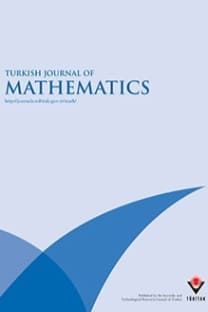Representation numbers of seven quaternary quadratic forms each in a genus consisting of only two classes
Representation numbers of seven quaternary quadratic forms each in a genus consisting of only two classes
___
- [1] Alaca A. Representations by quaternary quadratic forms whose coefficients are 1, 3 and 9. Acta Arithmetica 2009; 136: 151-166.
- [2] Alaca A. Representations by quaternary quadratic forms with coefficients 1, 3, 5 or 15. INTEGERS 2018; 18: 14.
- [3] Alaca A, Alaca Ş, Aygin ZS. Theta products and eta quotients of level 24 and weight 2. Functiones et Approximatio Commentarii Mathematici 2010; 57: 205-234.
- [4] Alaca A, Alaca Ş, Aygin ZS, Williams KS. Infinite products with coefficients which vanish on certain arithmetic progressions. International Journal of Number Theory 2017; 13: 1095-1117.
- [5] Alaca A, Alaca Ş, Lemire MF, Williams KS. Jacobi’s identity and representations of integers by certain quaternary quadratic forms. International Journal of Modern Mathematics 2007; 2: 143-176.
- [6] Alaca A, Alaca Ş, Lemire MF, Williams KS. Theta function identities and representations by certain quaternary quadratic forms II. International Mathematical Forum 2008; 3: 539-579.
- [7] Alaca A, Alaca Ş, Williams KS. Evaluation of the convolution sums ∑ l+12m=n σ(l)σ(m) and ∑ 3l+4m=n σ(l)σ(m). Advances in Theoretical and Applied Mathematics 2006; 1: 27-48.
- [8] Alaca A, Alaca Ş, Williams KS. On the quaternary forms, x 2+y 2+z 2+5t 2 , x 2+y 2+5z 2+5t 2 and x 2+5y 2+5z 2+5t 2 . JP Journal of Algebra, Number Theory and Applications 2007; 9: 37-53.
- [9] Alaca A, Alaca Ş, Williams KS. Some new theta function identities with applications to sextenary quadratic forms. Journal of Combinatorics and Number Theory 2009; 1: 89-98.
- [10] Alaca A, Alanazi J. Representations by quaternary quadratic forms with coefficients 1, 2, 7 or 14. INTEGERS 2016; 16: 16.
- [11] Alaca A, Altiary M. Representations by quaternary quadratic forms with coefficients 1, 2, 5 or 10. Communications of the Korean Mathematical Society 2019; 34: 27-41.
- [12] Alaca Ş, Pehlivan L, Williams KS. On the number of representations of a positive integer as a sum of two binary quadratic forms. International Journal of Number Theory 2014; 10: 1395-1420.
- [13] Alaca Ş, Williams KS. The number of representations of a positive integer by certain octonary quadratic forms. Functiones et Approximatio Commentarii Mathematici 2010; 43: 45-54.
- [14] Berndt BC. Number Theory in the Spirit of Ramanujan. Providence, RI, USA: American Mathematical Society Student Mathematical Library, 2006.
- [15] Kilford LJP. Modular Forms: A Classical and Computational Introduction. 2nd edition. London, UK: Imperial College Press, 2015.
- [16] Köhler G. Eta Products and Theta Series Identities. Springer Monographs in Mathematics. Berlin, Germany: Springer, 2011.
- [17] Nipp GL. Quaternary Quadratic Forms. New York, NY, USA: Springer-Verlag, 1991.
- [18] Wang X, Pei D. Modular Forms with Integral and Half-Integral Weights. Berlin, Germany: Springer, 2012.
- ISSN: 1300-0098
- Yayın Aralığı: 6
- Yayıncı: TÜBİTAK
4-generated pseudo symmetric monomial curves with not Cohen–Macaulay tangent cones
The Hewitt realcompactification of an orbit space
Entire large positive radial symmetry solutions for combined quasilinear elliptic system
Games relating to weak covering properties in bitopological spaces
Mixed boundary value problem for a class of quasi-linear elliptic operators containing p-Laplacian
Isotropic Riemannian submersions
Bayram ŞAHİN, Feyza Esra ERDOĞAN
Olha KARPENKO, Oleksandr STANZHYTSKYI, Tetiana DOBRODZII
Ascending chains of ideals in the polynomial ring
Generating sets of an infinite semigroup of transformations preserving a zig-zag order
